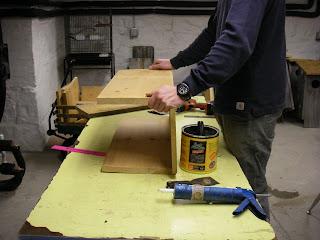
 Last week saw a significant amount of progress with the effort to monitor and maintain the duck nest boxes on White Memorial property. Scott Dayton, Dave Rosgen, and James Fischer all spent time out in the field trying to get to the rest of the boxes that hadn't been checked yet for usage in 2010. We have now managed to get to all but one box. This remaining box is standing in 5 feet of open water at Ceder Pond. Given the subfreezing temperatures that have characterized much of this past month it is amazing that any open water can be found in local ponds. However, springs, seeps, and water currents can create openings in some ponds. That's why they can be very dangerous in the winter. Ice can form over these spots, but will be much thinner than on the rest of the pond. These spots can also be meccas for wildlife when the water is open. When we checked the duck boxes at Heron Pond we saw tracks of Bobcat, Deer, Squirrels, Mice, and Juncos around seeps that line much of the west side of this pond. We also saw a flock of Robins in the area. They frequently forage for invertebrate animal food in seeps. Getting back to the subject of the duck boxes, we took down several more that needed major maintenance and later re-location to spots on higher ground (see an earlier post). The photo above shows several of the boxes that Scott and I rebuilt so far. We also built 3 new boxes. The top photo shows one of these in the construction process. The size of these nest boxes is so large that it is much easier for two people to build one. One person holds the component parts while the other uses a cordless drill to screw them together. We always use drywall or deck screws, never nails, because they do a much better job of holding the box together. Once the box is completed, the seams between the top and sides and the back and sides are caulked. This helps keep the boxes resistant to rain and cold drafts.
Last week saw a significant amount of progress with the effort to monitor and maintain the duck nest boxes on White Memorial property. Scott Dayton, Dave Rosgen, and James Fischer all spent time out in the field trying to get to the rest of the boxes that hadn't been checked yet for usage in 2010. We have now managed to get to all but one box. This remaining box is standing in 5 feet of open water at Ceder Pond. Given the subfreezing temperatures that have characterized much of this past month it is amazing that any open water can be found in local ponds. However, springs, seeps, and water currents can create openings in some ponds. That's why they can be very dangerous in the winter. Ice can form over these spots, but will be much thinner than on the rest of the pond. These spots can also be meccas for wildlife when the water is open. When we checked the duck boxes at Heron Pond we saw tracks of Bobcat, Deer, Squirrels, Mice, and Juncos around seeps that line much of the west side of this pond. We also saw a flock of Robins in the area. They frequently forage for invertebrate animal food in seeps. Getting back to the subject of the duck boxes, we took down several more that needed major maintenance and later re-location to spots on higher ground (see an earlier post). The photo above shows several of the boxes that Scott and I rebuilt so far. We also built 3 new boxes. The top photo shows one of these in the construction process. The size of these nest boxes is so large that it is much easier for two people to build one. One person holds the component parts while the other uses a cordless drill to screw them together. We always use drywall or deck screws, never nails, because they do a much better job of holding the box together. Once the box is completed, the seams between the top and sides and the back and sides are caulked. This helps keep the boxes resistant to rain and cold drafts.
No comments:
Post a Comment